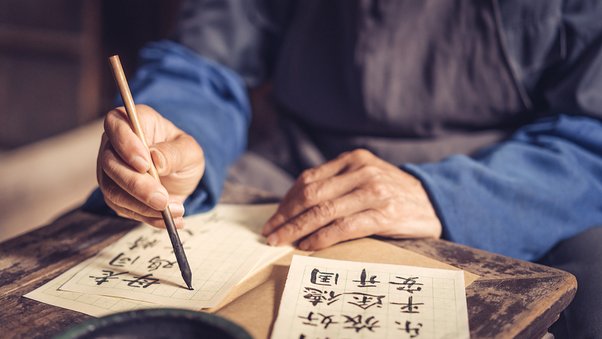By Janet Tse
Janet Tse has 25 years of teaching experience and over 30 years participation in environmental protection, along with practicing and coaching mindfulness meditation. Her qualifications include a Master of Buddhist Studies (MBS, HKU), Master of Business Administration (MBA, HKBU), Certificate in MEDPAC Drug Abuse Quitline (HKU), Mental Health First Aid (MHFA) International / Hong Kong, and Nature Dao Elementary Tutor Training.
—
Studies reported a high level of stress among Hong Kong residents during the global pandemic. Approximately 50 per cent of Hong Kong residents experienced stress, depression, or severe anxiety, with many seeking professional support for their emotional well-being. While complementary therapies like art therapy have been widely used for stress relief and have been subject to various experiments, there has been limited research on the use of Buddhist calligraphy as an alternative method for stress relief. Despite Chinese calligraphy being recognized as an effective tool for improving emotional calmness and relaxation, the potential of Buddhist calligraphy in relieving stress has not been explored extensively. This research aims to investigate the relationship between Buddhist calligraphy and stress relief.
The study invited voluntary participants aged 18 and above from various calligraphy classes, associations, and friend groups in Hong Kong. Participants were asked to complete a questionnaire reporting their psychological and behavioral data, as well as their experiences, views, and comments related to the practice of Buddhist calligraphy, Chinese calligraphy, and stress examination. The data and findings from the questionnaires revealed that a majority of participants from the Buddhist calligraphy group reported feeling more relaxed, less stressed, experiencing a reduced level of insomnia, decreased irritability, improved appetite, less depression, less anxiety, and fewer headaches.
Over 50 per cent of respondents agreed or strongly agreed that practicing Buddhist calligraphy made it easier for them to relax, brought inner peace, improved their focus, increased their enjoyment, and made them happier. They disagreed or strongly disagreed with experiencing emotional changes, a scattered mind, or increased suffering compared to practicing Chinese calligraphy. Therefore, respondents reported improvements in relaxation, inner peace, concentration, enjoyment, happiness, and emotional stability during the practice of Buddhist calligraphy.
The promising results of Buddhist calligraphy are similar to the initial stages of mindfulness and Jhana practices. Both Buddhist and Chinese calligraphy, like meditation, can serve as alternative methods for developing mental concentration, improving calmness, reducing stress, and promoting happiness among adults in Hong Kong. Buddhists reported finding it easier to relax, being happier, experiencing more enjoyment, and having greater inner peace compared to non-Buddhists during the practice of Buddhist calligraphy, likely due to their alignment with Buddhist Sutras or Scriptures.
Regardless of whether participants had taken refuge in Buddhism or not, there was no difference in respondents’ ability to relax, experience inner peace, maintain focus, be more sensitive to their senses, enjoy more, be happier, experience more suffering, or have a scattered mind during the practice of Buddhist calligraphy. These results are crucial for considering Buddhist calligraphy as an alternative therapy alongside conventional and recognized methods, contributing to the overall well-being of society.

The findings of this research provide evidence that Buddhist calligraphy can be an effective tool for stress relief in times of future pandemics or disasters (dukkha). Further scientific studies on Buddhist calligraphy meditation are undoubtedly warranted. Emotion regulation is vital for a healthy lifestyle, and during challenging periods like the global pandemic, Buddhist calligraphy can serve as an effective tool for mental training and mindfulness meditation, as supported by the results of this research. The observed improvements in relaxation, inner peace, concentration, enjoyment, happiness, and emotional stability during the practice of Buddhist calligraphy are noteworthy. Calligraphers can experience joyful, relaxing, calm, and happy present moments without intentionally focusing on specific outcomes or aims, aligning with the concept of “not-self.”
Various Buddhist calligraphy classes that emphasize mindfulness are currently being promoted, such as the Calligraphy Art Therapy Group Training and Application Course (Online Course). These courses cater to different individuals in need, including those suffering from depression, mild to moderate mental disabilities, or dementia. They aim to relieve emotions, manage stress, and improve both physical and mental health. Additionally, these courses can aid children with special learning needs in enhancing cognitive abilities such as observation and concentration, reducing impulsiveness, promoting relaxation, strengthening hand-eye coordination, and building self-confidence. Furthermore, these courses provide guidance on generating positive energy, relaxing the body and mind, achieving inner peace and stability, and attaining a state of selflessness and concentration.
Moreover, Buddhist calligraphy can be practiced individually at home or any other location, offering an accessible and convenient complementary therapy option and a contemplation tool for cultivating mental calmness and purifying the mind. The practice of Buddhist calligraphy can serve as a foundational approach to mindfulness meditation, concentration (samadhi), and tranquility (samatha). People are encouraged to learn Buddhist calligraphy as a means to overcome the various challenges they face today, particularly in the aftermath of the pandemic.
Based on the findings of this research, further comprehensive studies and experiments are strongly recommended to explore and test the acceptance of Buddhist calligraphy as a complementary therapy. Additionally, research on Chinese calligraphy in other religious scriptures and philosophical discourses could be explored to expand our understanding of its potential benefits.
Related blog posts from BDG
Buddhist Calligraphy Meditation in Relationship to Stress: Part One


